Oldsmobile Achieva 1997 Owner's Manuals
Manufacturer: OLDSMOBILE, Model Year: 1997, Model line: Achieva, Model: Oldsmobile Achieva 1997Pages: 372, PDF Size: 18.52 MB
Page 201 of 372
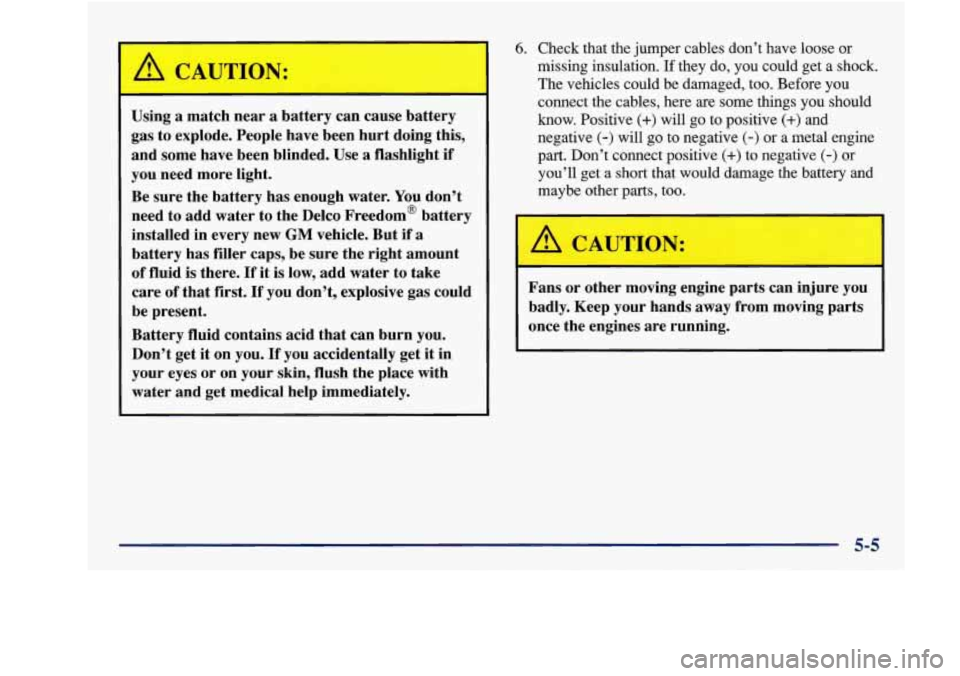
A CAUTION:
Using a match near a battery can cause battery
gas to explode. People have been hurt doing this, and some have been blinded. Use
a flashlight if
you need more light.
Be sure the battery
has enough water. You don’t
need to add water to the Delco Freedom@ battery
installed in every new
GM vehicle. But if a
battery has filler caps, be sure the right amount
of fluid is there.
If it is low, add water to take
care of that first. If you don’t, explosive gas could
be present.
Battery fluid contains acid that can burn you.
Don’t get it on you. If you accidentally get it in
your eyes or on your skin, flush the place with
water and get medical help immediately.
6. Check that the jumper cables don’t have loose or
missing insulation.
If they do, you could get a shock.
The vehicles could be damaged, too. Before you
connect the cables, here are some things
you should
know. Positive (+) will go to positive (+) and
negative
(-) will go to negative (-) or a metal engine
part. Don’t connect positive
(+) to negative (-) or
you’ll get a short that would damage the battery and
maybe other
parts, too.
Fans or other moving engine parts can injure you
badly. Keep your hands away from moving parts
once the engines are running.
5-5
Page 202 of 372
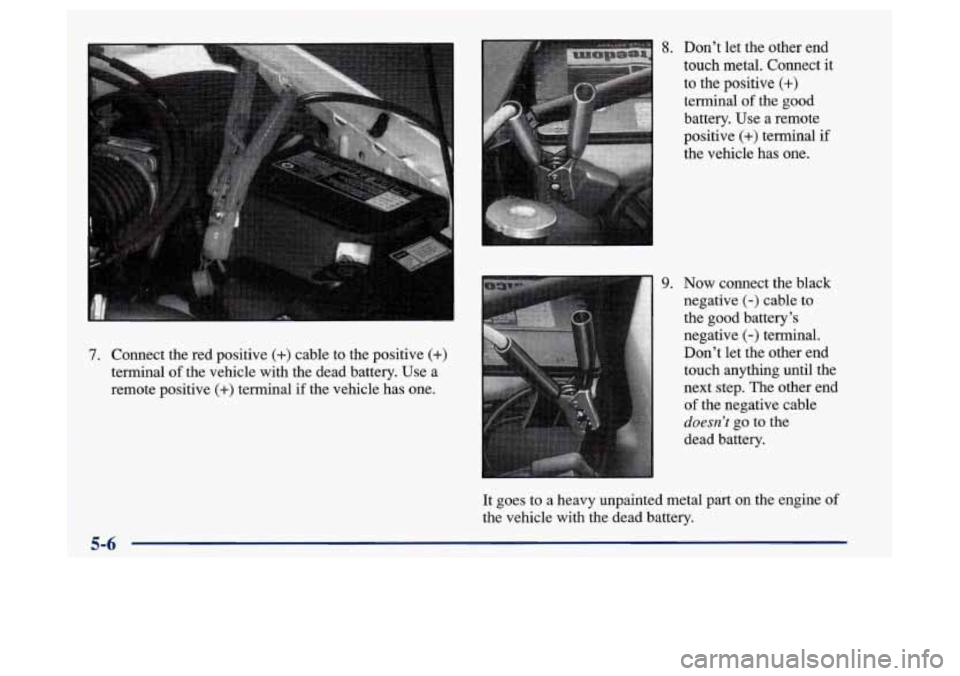
7. Connect the red positive (+) cable to the positive (+)
terminal of the vehicle with the dead battery. Use a
remote positive
(+) terminal if the vehicle has one.
8. Don’t let the other end
touch metal. Connect it
to the positive
(+)
terminal of the good
battery. Use a remote
positive
(+) terminal if
the vehicle has one.
9. Now connect the black
negative
(-) cable to
the
good battery’s
negative
(-) terminal.
Don’t let the other end
touch anything until the
next step. The other end
of the negative cable
doesn’t go to the
dead battery.
It goes to a heavy unpainted metal part on the engine of
the vehicle with the dead battery.
5-6
Page 203 of 372
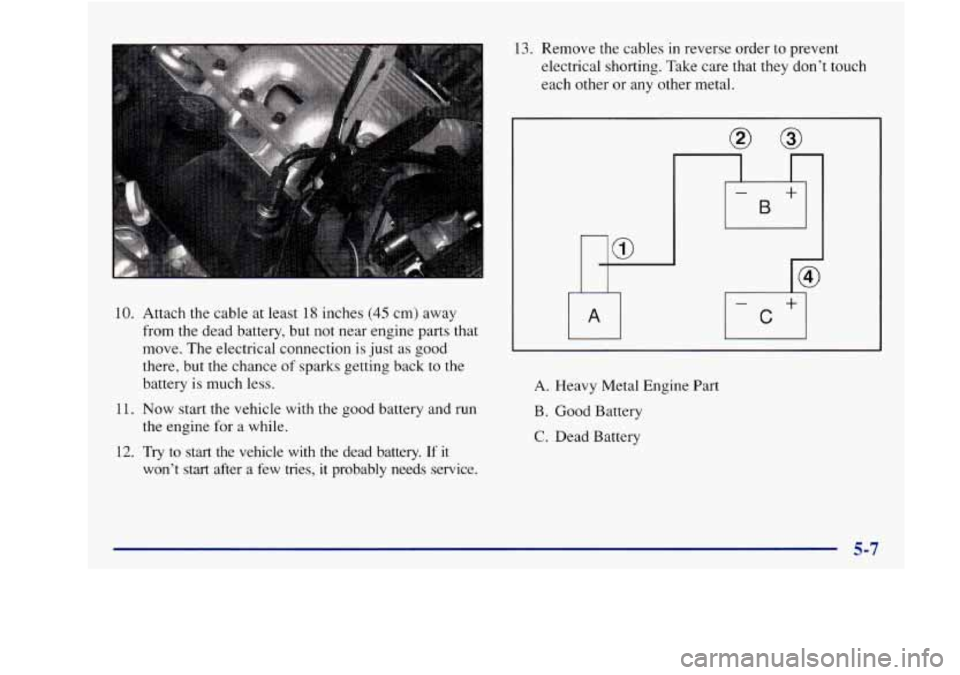
10. Attach the cable at least 18 inches (45 cm) away
from the dead battery, but not near engine parts that
move. The electrical connection
is just as good
there, but
the chance of sparks getting back to the
battery is much less.
11. Now start the vehicle with the good battery and run
the engine for a while.
12. Try to start the vehicle with the dead battery. If it
won’t start after a few tries,
it probably needs service.
13. Remove the cables in reverse order to prevent
electrical shorting. Take care that
they don’t touch
each other or any other metal.
no I
A. Heavy Metal Engine Part
B. Good Battery
C. Dead Battery
5-7
Page 204 of 372
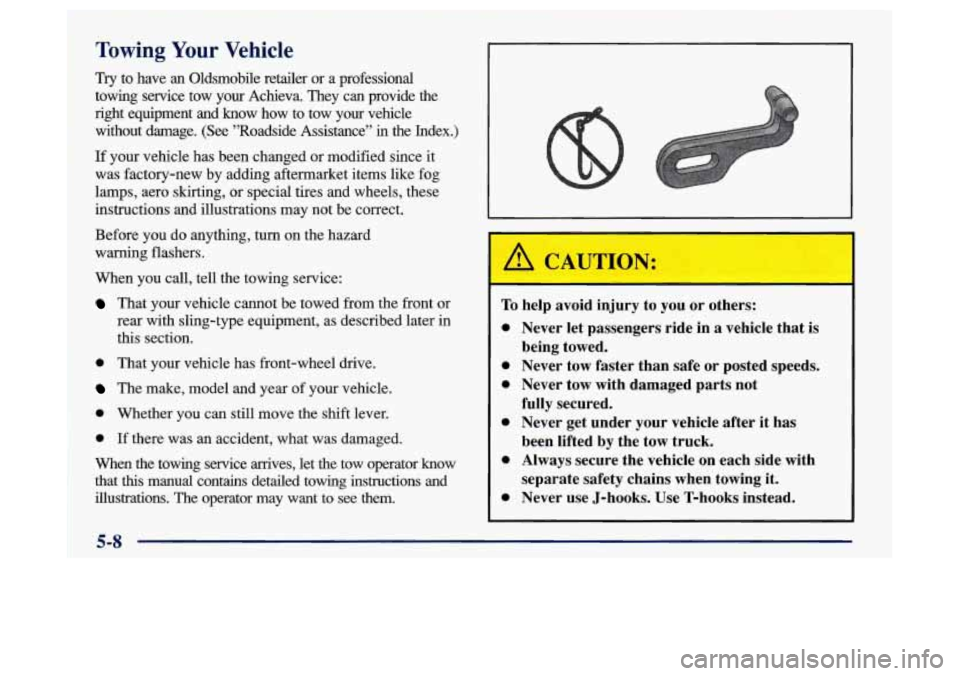
Towing Your Vehicle
Try to have an Oldsmobile retailer or a professional
towing service tow your Achieva. They can provide the
right equipment and know how to tow your vehicle without damage. (See ”Roadside Assistance” in the Index.)\
If your vehicle has been changed or modified since it
was factory-new by adding aftermarket items like fog
lamps, aero skirting, or special tires and wheels, these
instructions and illustrations may not be correct.
Before you do anything,
turn on the hazard
warning flashers.
When you call, tell the towing service:
That your vehicle cannot be towed from the front or
rear with sling-type equipment, as described later
in
this section.
0 That your vehicle has front-wheel drive.
The make, model and year of your vehicle.
0 Whether you can still move the shift lever.
0 If there was an accident, what was damaged.
When the towing service arrives, let
the tow operator know
that
this manual contains detailed towing instructions and
illustrations. The operator may want to see them.
I
t- To help avoid injury to you or others:
0
0
I. 0
0
0
Never let passengers ride in a vehicle that is
being towed.
Never tow faster than safe
or posted speeds.
Never tow with damaged parts not
fully secured.
Never get under your vehicle after it has
been lifted by the tow truck.
Always secure the vehicle on each side with
separate safety chains when towing
it.
Never use J-hooks. Use T-hooks instead.
5-8
Page 205 of 372
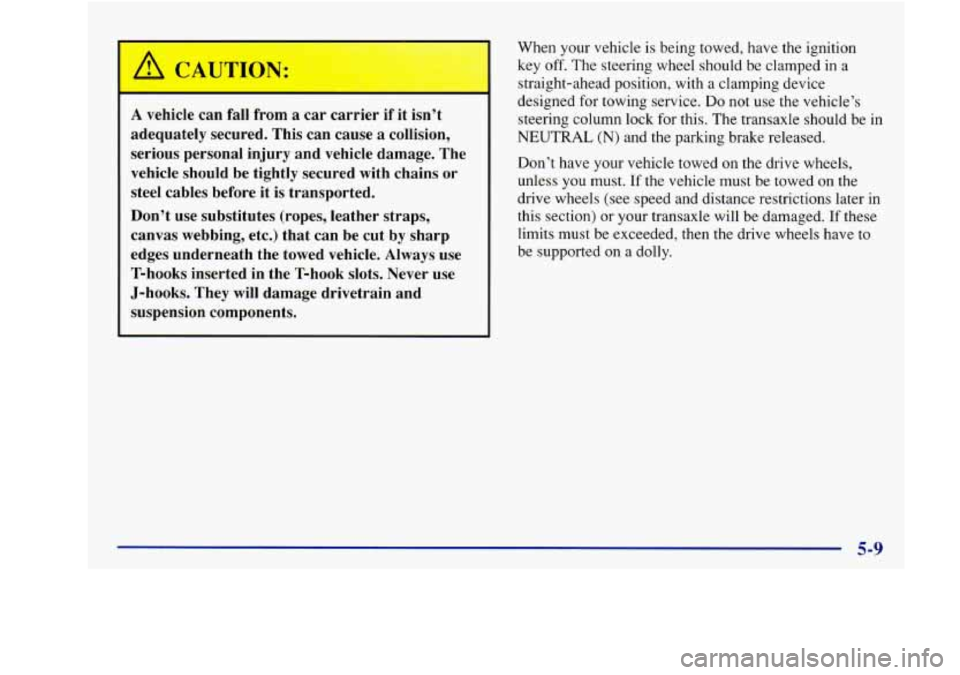
I /A CAUTION:
r
A vehicle can fall from a car carrier if it isn’t
adequately secured. This can cause
a collision,
serious personal injury and vehicle damage. The
vehicle should be tightly secured with chains or
steel cables before it
is transported.
Don’t use substitutes (ropes, leather straps,
canvas webbing, etc.) that can be cut
by sharp
edges underneath the towed vehicle. Always use
T-hooks inserted in the T-hook slots. Never use
J-hooks. They will damage drivetrain and
suspension components. When your
vehicle is being towed, have the ignition
key off. The steering wheel should be clamped
in a
straight-ahead position, with a clamping device
designed for towing service.
Do not use the vehicle’s
steering column lock for this. The transaxle should be in
NEUTRAL (N) and the parking brake released.
Don’t have your vehicle towed
on the drive wheels,
unless you must. If the vehicle must be towed on the
drive wheels (see speed and distance restrictions later in
this section) or your transaxle will be damaged. If these
limits must be exceeded, then the drive wheels have to
be supported on a dolly.
Page 206 of 372
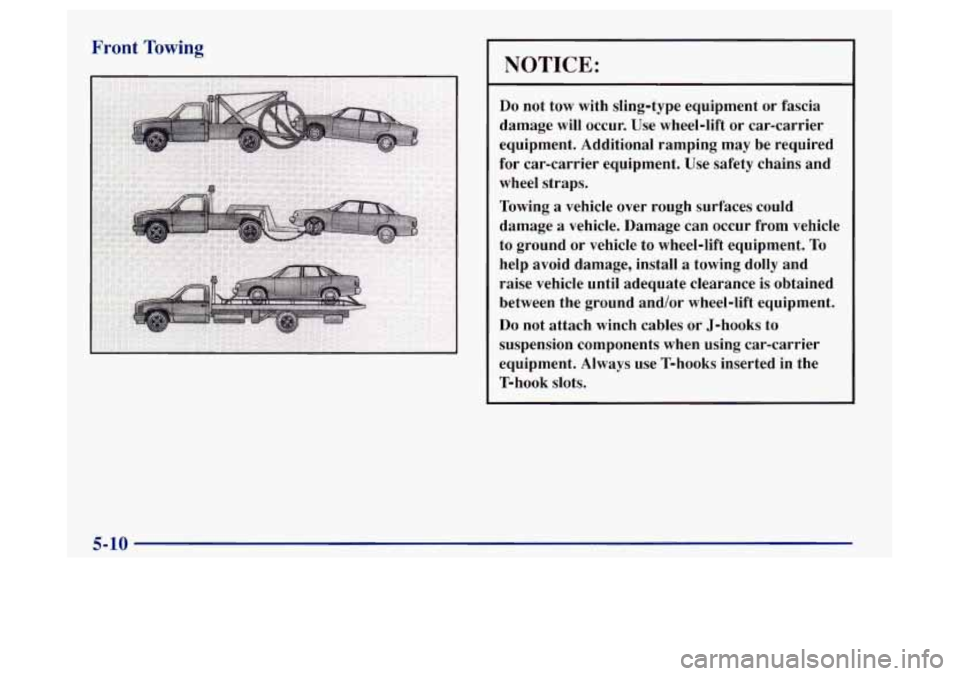
Front Towing
NOTICE:
Do not tow with sling-type equipment or fascia
damage will occur. Use wheel-lift or car-carrier
equipment. Additional ramping may be required
for car-carrier equipment. Use safety chains and
wheel straps.
Towing
a vehicle over rough surfaces could
damage
a vehicle. Damage can occur from vehicle
to ground or vehicle to wheel-lift equipment. To
help avoid damage, install
a towing dolly and
raise vehicle until adequate clearance
is obtained
between the ground and/or wheel-lift equipment.
Do not attach winch cables or J-hooks to
suspension components when using car-carrier
equipment. Always use T-hooks inserted in the
T-hook slots.
5-10
Page 207 of 372
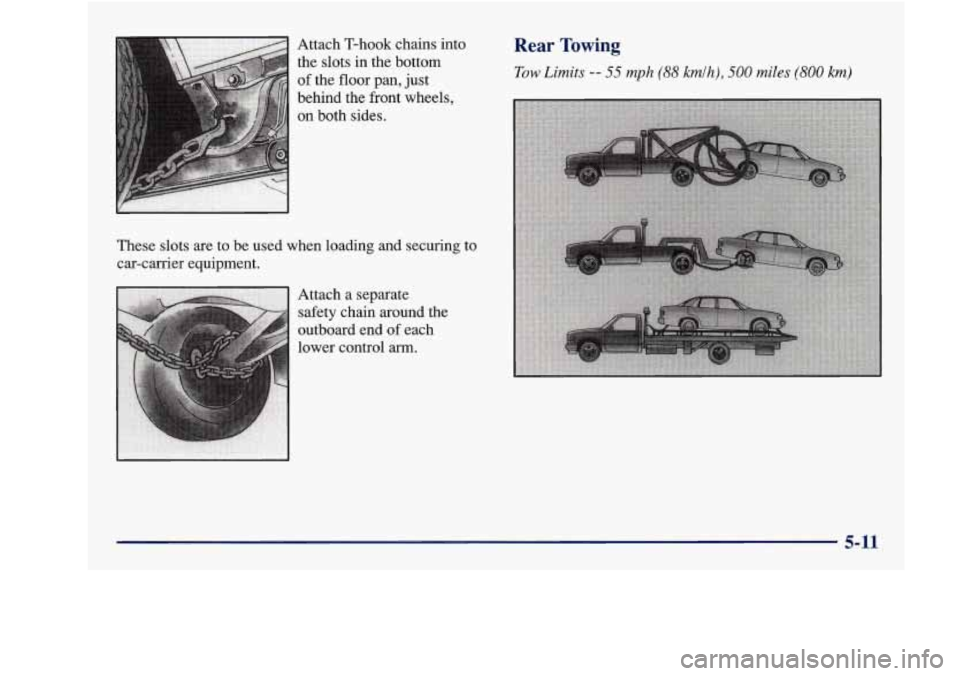
Attach T-hook chains into
the slots in the bottom
of the floor pan, just
behind the front wheels,
on both sides.
These slots are to be used when loading and securing to
car-carrier equipment.
Attach a separate safety chain around the
outboard end of each
lower control
arm.
Rear Towing
Tow Limits -- 55 mph (88 kmlh), 500 miles (800 km)
5-11
Page 208 of 372
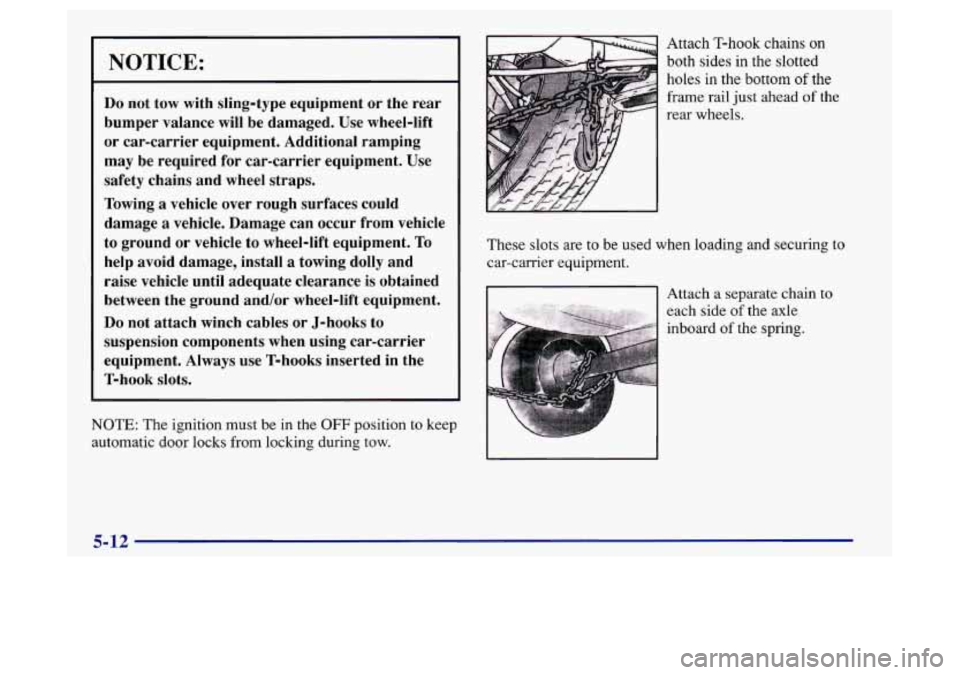
NOTICE:
Do not tow with sling-type equipment or the rear
bumper valance will be damaged. Use wheel-lift
or car-carrier equipment. Additional ramping
may be required for car-carrier equipment. Use
safety chains and wheel straps.
Towing
a vehicle over rough surfaces could
damage a vehicle. Damage can occur from vehicle
to ground
or vehicle to wheel-lift equipment. To
help avoid damage, install a towing dolly and
raise vehicle until adequate clearance is obtained
between the ground and/or wheel-lift equipment.
Do not attach winch cables or J-hooks to
suspension components when using car-carrier
equipment. Always use T-hooks inserted in the
T-hook slots.
NOTE: The ignition must be in the
OFF position to keep
automatic door locks from locking during tow. Attach
T-hook chains on
both sides in the slotted
holes in the bottom of the
frame rail just ahead of the
rear wheels.
These slots are to be used when loading and securing to
car-carrier equipment.
11 Attach a separate chain to
5-12
Page 209 of 372
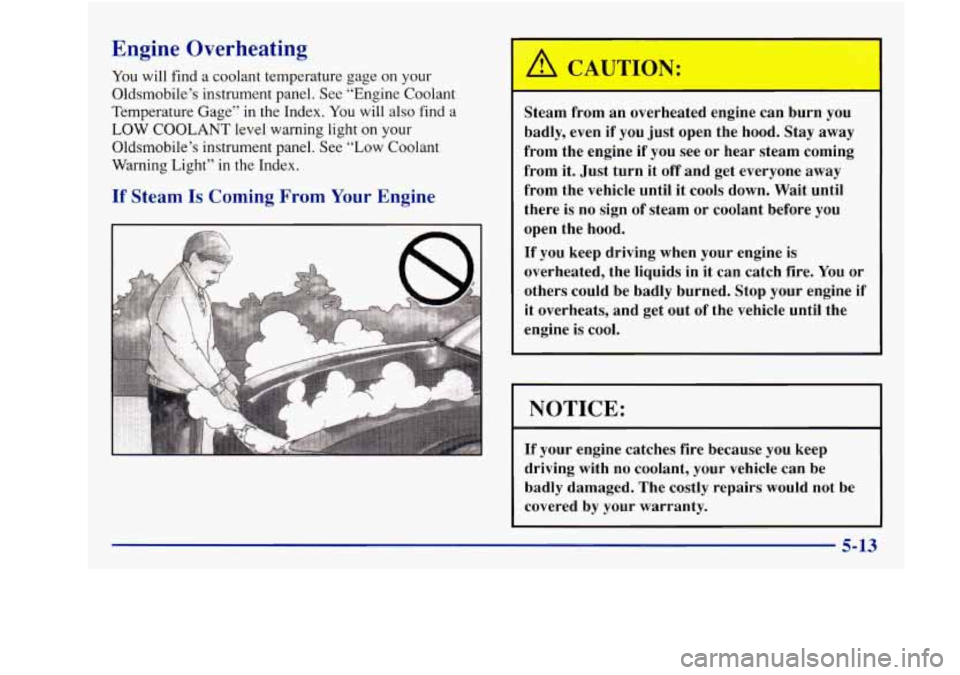
Engine Overheating
You will find a coolant temperature gage on your
Oldsmobile’s instrument panel. See “Engine Coolant
Temperature Gage” in the Index.
You will also find a
LOW COOLANT level warning light on your
Oldsmobile’s instrument panel. See “Low Coolant
Warning Light” in the Index.
If Steam Is Coming From Your Engine
/r CAUTION:
Steam from an overheated engine can burn you
badly, even
if you just open the hood. Stay away
from the engine if you see or hear steam coming
from it. Just turn it
off and get everyone away
from the vehicle until it cools down. Wait until
there is no sign of steam or coolant before
you
open the hood.
If you keep driving when your engine is
overheated, the liquids in it can catch fire. You or
others could be badly burned. Stop your engine if
it overheats, and get out of the vehicle until the
engine is cool.
I i
NOTICE:
If your engine catches fire because you keep
driving with no coolant, your vehicle can be
badly damaged. The costly repairs would not be
covered by your warranty.
Page 210 of 372
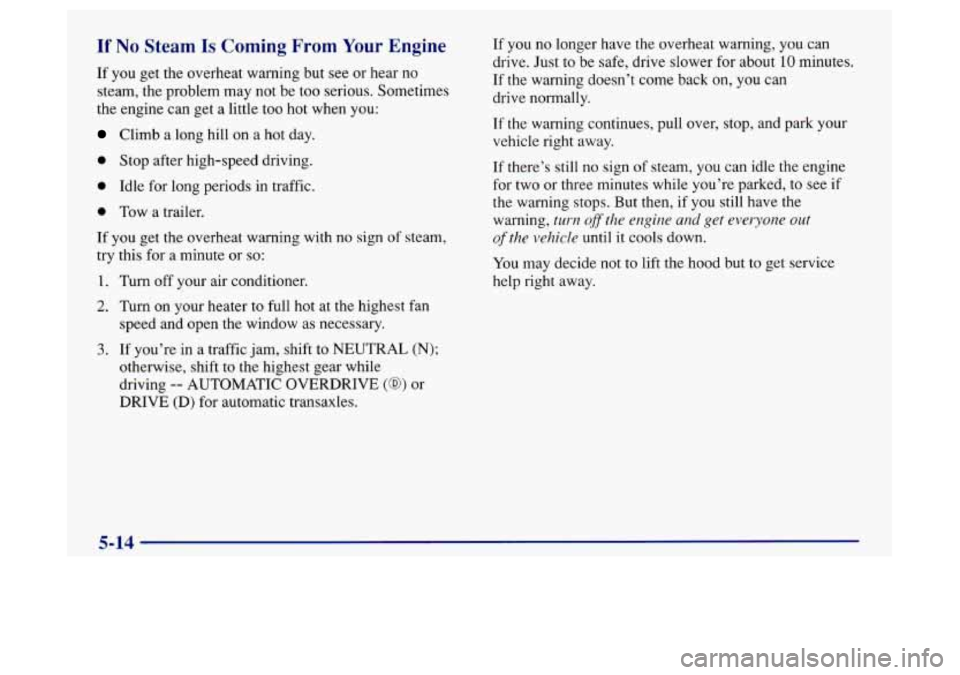
If No Steam Is Coming From Your Engine
If you get the overheat warning but see or hear no
steam, the problem may not be too serious. Sometimes
the engine can get a little too hot when you:
Climb a long hill on a hot day.
0 Stop after high-speed driving.
0 Idle for long periods in traffic.
0 Tow a trailer.
If you get the overheat warning with no sign of steam,
try this for a minute or
so:
1. Turn off your air conditioner.
2. Turn on your heater to full hot at the highest fan
speed and open the window as necessary.
3. If you’re in a traffic jam, shift to NEUTRAL (N);
otherwise, shift to the highest gear while
driving
-- AUTOMATIC OVERDRIVE (@) or
DRIVE
(D) for automatic transaxles. If
you no longer have the overheat warning, you can
drive. Just
to be safe, drive slower for about 10 minutes.
If
the warning doesn’t come back on, you can
drive normally.
If
the warning continues, pull over, stop, and park your
vehicle right away.
If there’s still
no sign of steam, you can idle the engine
for two or three minutes while you’re parked, to see if
the warning stops. But then,
if you still have the
warning,
turn ofthe engine and get everyone out
of the vehicle until it cools down.
You may decide not to lift the hood but to get service
help right away.